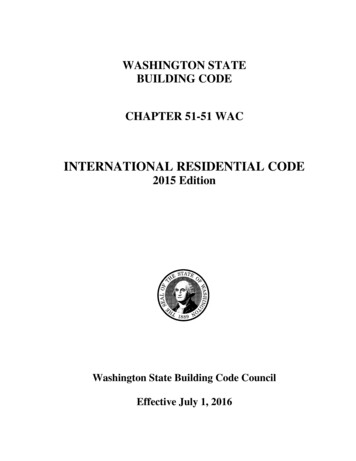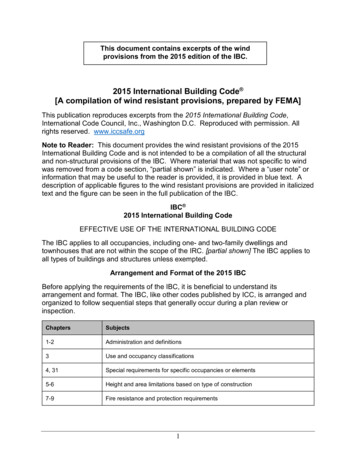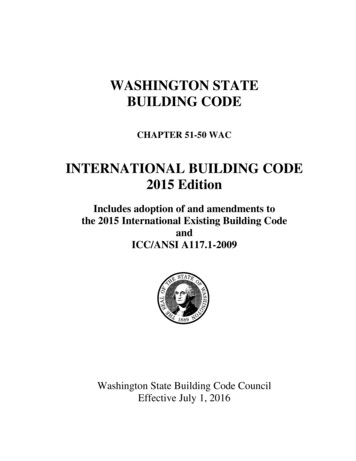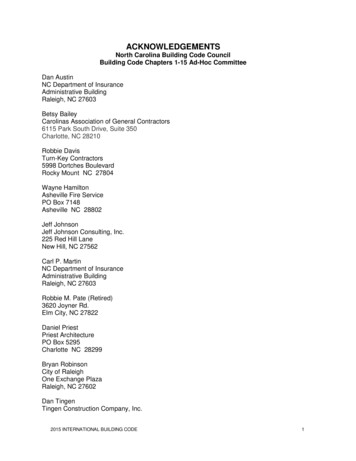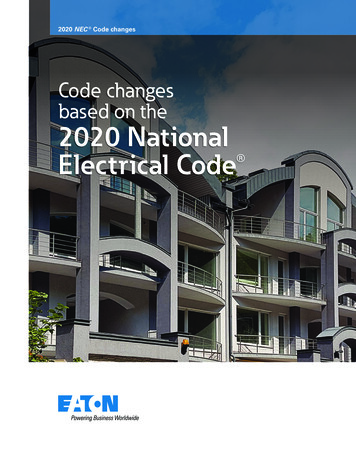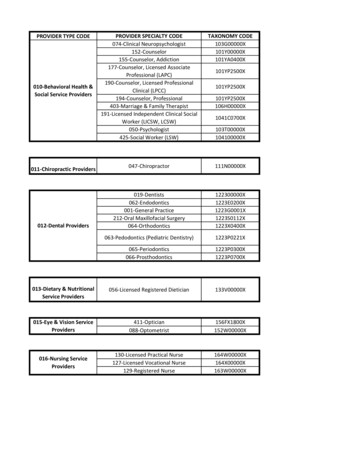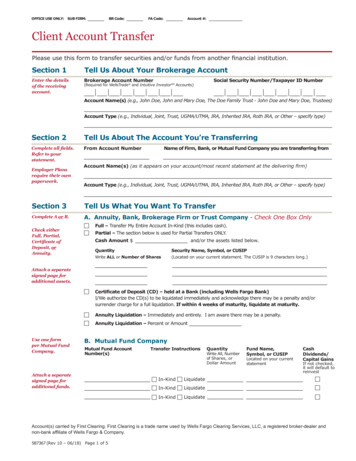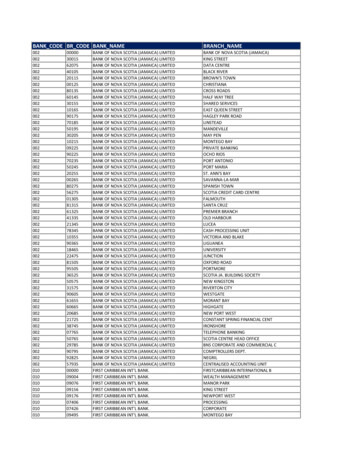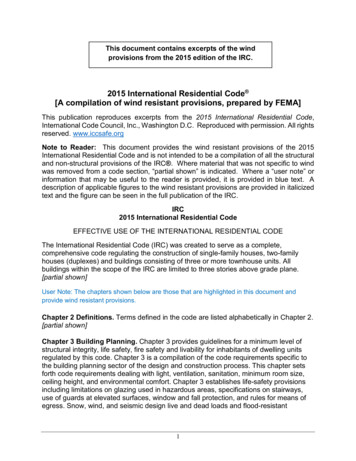
Transcription
This document contains excerpts of the windprovisions from the 2015 edition of the IRC.2015 International Residential Code [A compilation of wind resistant provisions, prepared by FEMA]This publication reproduces excerpts from the 2015 International Residential Code,International Code Council, Inc., Washington D.C. Reproduced with permission. All rightsreserved. www.iccsafe.orgNote to Reader: This document provides the wind resistant provisions of the 2015International Residential Code and is not intended to be a compilation of all the structuraland non-structural provisions of the IRC . Where material that was not specific to windwas removed from a code section, “partial shown” is indicated. Where a “user note” orinformation that may be useful to the reader is provided, it is provided in blue text. Adescription of applicable figures to the wind resistant provisions are provided in italicizedtext and the figure can be seen in the full publication of the IRC.IRC2015 International Residential CodeEFFECTIVE USE OF THE INTERNATIONAL RESIDENTIAL CODEThe International Residential Code (IRC) was created to serve as a complete,comprehensive code regulating the construction of single-family houses, two-familyhouses (duplexes) and buildings consisting of three or more townhouse units. Allbuildings within the scope of the IRC are limited to three stories above grade plane.[partial shown]User Note: The chapters shown below are those that are highlighted in this document andprovide wind resistant provisions.Chapter 2 Definitions. Terms defined in the code are listed alphabetically in Chapter 2.[partial shown]Chapter 3 Building Planning. Chapter 3 provides guidelines for a minimum level ofstructural integrity, life safety, fire safety and livability for inhabitants of dwelling unitsregulated by this code. Chapter 3 is a compilation of the code requirements specific tothe building planning sector of the design and construction process. This chapter setsforth code requirements dealing with light, ventilation, sanitation, minimum room size,ceiling height, and environmental comfort. Chapter 3 establishes life-safety provisionsincluding limitations on glazing used in hazardous areas, specifications on stairways,use of guards at elevated surfaces, window and fall protection, and rules for means ofegress. Snow, wind, and seismic design live and dead loads and flood-resistant1
construction, as well as solar energy systems, and swimming pools, spas, and hot tubs,are addressed in this chapter.Chapter 4 Foundations. Chapter 4 provides the requirements for the design andconstruction of foundation systems for buildings regulated by this code. Provisions forseismic load, flood load and frost protection are contained in this chapter. [partialshown]Chapter 5 Floors. Chapter 5 provides the requirements for the design and constructionof floor systems that will be capable of supporting minimum required design loads.[partial shown]Chapter 6 Wall Construction. Chapter 6 contains provisions that regulate the designand construction of walls. The wall construction covered in Chapter 6 consists of fivedifferent types: wood framed, cold-formed steel framed, masonry, concrete andstructural insulated panel (SIP). The primary concern of this chapter is the structuralintegrity of wall construction and transfer of all imposed loads to the supportingstructure. This chapter provides the requirements for the design and construction of wallsystems that are capable of supporting the minimum design vertical loads (dead, liveand snow loads) and lateral loads (wind or seismic loads). This chapter contains theprescriptive requirements for wall bracing and/or shear walls to resist the imposedlateral loads due to wind and seismic.Chapter 6 also regulates exterior windows and doors installed in walls. The chaptercontains criteria for the performance of exterior windows and doors and includesprovisions for testing and labeling, garage doors, wind-borne debris protection andanchorage details.Chapter 7 Wall Covering. Chapter 7 contains provisions for the design andconstruction of interior and exterior wall coverings. This chapter establishes the varioustypes of materials, materials standards and methods of application permitted for use asinterior coverings, including interior plaster, gypsum board, ceramic tile, wood veneerpaneling, hardboard paneling, wood shakes and wood shingles. Chapter 7 also containsrequirements for the use of vapor retarders for moisture control in walls.Exterior wall coverings provide the weather-resistant exterior envelope that protects thebuilding’s interior from the elements. Chapter 7 provides the requirements for windresistance and water-resistive barrier for exterior wall coverings. This chapter prescribesthe exterior wall coverings as well as the water-resistive barrier required beneath theexterior materials. Exterior wall coverings regulated by this section include aluminum,stone and masonry veneer, wood, hardboard, particleboard, wood structural panelsiding, wood shakes and shingles, exterior plaster, steel, vinyl, fiber cement and exteriorinsulation finish systems.Chapter 8 Roof-ceiling Construction. Chapter 8 regulates the design andconstruction of roof-ceiling systems. This chapter contains two roof-ceiling framingsystems: wood framing and cold-formed steel framing. Allowable span tables are2
provided to simplify the selection of rafter and ceiling joist size for wood roof framingand cold-formed steel framing. [partial shown]Chapter 9 Roof Assemblies. Chapter 9 regulates the design and construction of roofassemblies. A roof assembly includes the roof deck, vapor retarder, substrate orthermal barrier, insulation, vapor retarder and roof covering. This chapter provides therequirement for wind resistance of roof coverings.The types of roof covering materials and installation regulated by Chapter 9 are: asphaltshingles, clay and concrete tile, metal roof shingles, mineral-surfaced roll roofing, slateand slate-type shingles, wood shakes and shingles, built-up roofs, metal roof panels,modified bitumen roofing, thermoset and thermoplastic single-ply roofing, sprayedpolyurethane foam roofing, liquid applied coatings and photovoltaic shingles. Chapter 9also provides requirements for roof drainage, flashing, above deck thermal insulation,rooftop-mounted photovoltaic systems and recovering or replacing an existing roofcovering.Chapter 44 Referenced Standards. The code contains numerous references tostandards that are used to regulate materials and methods of construction. Chapter 44contains a comprehensive list of all standards that are referenced in the code. [partialshown]Appendix E Manufactured Housing Used as Dwellings. The criteria for theconstruction of manufactured homes are governed by the National ManufacturedHousing Construction and Safety Act. [partial shown]Appendix H Patio Covers. Appendix H sets forth the regulations and limitations forpatio covers. The provisions address those uses permitted in patio cover structures, theminimum design loads to be assigned for structural purposes, and the effect of the patiocover on egress and emergency escape or rescue from sleeping rooms. This appendixalso contains the special provisions for aluminum screen enclosures in hurricane-proneregions.Appendix R Light Straw-Clay Construction. This appendix regulates the use of lightstraw-clay as a construction material. It is limited in application to nonbearing wall infillsystems.Appendix S Strawbale Construction. This appendix provides prescriptiverequirements for the use of strawbale as a construction material. It is limited inapplication to the walls of one-story structures, except where additional engineering isprovided.3
CHAPTER 2DEFINITIONSSECTION R202DEFINITIONS[RB] BASIC WIND SPEED. Three-second gust speed at 33 feet (10 058 mm) abovethe ground in Exposure C (see Section R301.2.1) as given in Figure R301.2(4)A.[RB] CLADDING. The exterior materials that cover the surface of the building envelopethat is directly loaded by the wind.[RB] ESCARPMENT. With respect to topographic wind effects, a cliff or steep slopegenerally separating two levels or gently sloping areas.[RB] HILL. With respect to topographic wind effects, a land surface characterized bystrong relief in any horizontal direction.[RB] HURRICANE-PRONE REGIONS. Areas vulnerable to hurricanes, defined as theU.S. Atlantic Ocean and Gulf of Mexico coasts where the ultimate design wind speed,Vult, is greater than 115 miles per hour (51 m/s), and Hawaii, Puerto Rico, Guam, VirginIslands and America Samoa.[RB] RIDGE. With respect to topographic wind effects, an elongated crest of a hillcharacterized by strong relief in two directions.[RB] SHEAR WALL. A general term for walls that are designed and constructed toresist racking from seismic and wind by use of masonry, concrete, cold-formed steel orwood framing in accordance with Chapter 6 of this code and the associated limitationsin Section R301.2 of this code.[RB] WINDBORNE DEBRIS REGION. Areas within hurricane-prone regions located inaccordance with one of the following:1. Within 1 mile (1.61 km) of the coastal mean high water line where the ultimatedesign wind speed, Vult, is 130 mph (58 m/s) or greater.2. In areas where the ultimate design wind speed, Vult, is 140 mph (63.6 m/s) orgreater; or Hawaii.CHAPTER 3BUILDING PLANNINGSECTION R301DESIGN CRITERIAR301.2 Climatic and geographic design criteria. Buildings shall be constructed inaccordance with the provisions of this code as limited by the provisions of this section.Additional criteria shall be established by the local jurisdiction and set forth in TableR301.2(1).4
Table R301.2(1). Provides the climatic and geographic design criteria.Table R301.2(2). Provides component and cladding loads for a building with a meanroof height of 30 feet located in exposure B. This Table references Table R301.2(7),which defines the zones listed in Table R301.2(2).Table R301.2(3). Provides height and exposure adjustment coefficients for TableR301.(2).R301.2.1 Wind design criteria. Buildings and portions thereof shall be constructed inaccordance with the wind provisions of this code using the ultimate design wind speedin Table R301.2(1) as determined from Figure R301.2(4)A. The structural provisions ofthis code for wind loads are not permitted where wind design is required as specified inSection R301.2.1.1. Where different construction methods and structural materials areused for various portions of a building, the applicable requirements of this section foreach portion shall apply. Where not otherwise specified, the wind loads listed in TableR301.2(2) adjusted for height and exposure using Table R301.2(3) shall be used todetermine design load performance requirements for wall coverings, curtain walls, roofcoverings, exterior windows, skylights, garage doors and exterior doors. Asphaltshingles shall be designed for wind speeds in accordance with Section R905.2.4. Acontinuous load path shall be provided to transmit the applicable uplift forces in SectionR802.11.1 from the roof assembly to the foundation.5
FIGURE R301.2(4)A. ULTIMATE DESIGN WIND SPEEDSR301.2.1.1 Wind limitations and wind design required. The wind provisions of thiscode shall not apply to the design of buildings where wind design is required inaccordance with Figure R301.2(4)B.Exceptions:1. For concrete construction, the wind provisions of this code shall apply inaccordance with the limitations of Sections R404 and R608.2. For structural insulated panels, the wind provisions of this code shall apply inaccordance with the limitations of Section R610.3. For cold-formed steel light-frame construction, the wind provisions of this codeshall apply in accordance with the limitations of Sections R505, R603 and R804.In regions where wind design is required in accordance with Figure R301.2(4)B, thedesign of buildings for wind loads shall be in accordance with one or more of thefollowing methods:1. AF&PA Wood Frame Construction Manual (WFCM).2. ICC Standard for Residential Construction in High-Wind Regions (ICC 600).3. ASCE Minimum Design Loads for Buildings and Other Structures (ASCE 7).6
4. AISI Standard for Cold-Formed Steel Framing—Prescriptive Method For One- andTwo-Family Dwellings (AISI S230).5. International Building Code.The elements of design not addressed by the methods in Items 1 through 5 shall be inaccordance with the provisions of this code.Where ASCE 7 or the International Building Code is used for the design of the building,the wind speed map and exposure category requirements as specified in ASCE 7 andthe International Building Code shall be used.FIGURE R301.2(4)B. REGIONS WHERE WIND DESIGN IS REQUIRED7
R301.2.1.1.1 Sunrooms. Sunrooms shall comply with AAMA/NPEA/NSA 2100. For thepurpose of applying the criteria of AAMA/NPEA/NSA 2100 based on the intended use,sunrooms shall be identified as one of the following categories by the permit applicant,design professional or the property owner or owner’s agent in the constructiondocuments. Component and cladding pressures shall be used for the design ofelements that do not qualify as main windforce-resisting systems. Main windforceresisting system pressures shall be used for the design of elements assigned to providesupport and stability for the overall sunroom.Category I: A thermally isolated sunroom with walls that are open or enclosed withinsect screening or 0.5 mm (20 mil) maximum thickness plastic film. The space isnonhabitable and unconditioned.Category II: A thermally isolated sunroom with enclosed walls. The openings areenclosed with translucent or transparent plastic or glass. The space is nonhabitableand unconditioned.Category III: A thermally isolated sunroom with enclosed walls. The openings areenclosed with translucent or transparent plastic or glass. The sunroom fenestrationcomplies with additional requirements for air infiltration resistance and waterpenetration resist
text and the figure can be seen in the full publication of the IRC. IRC 2015 International Residential Code . EFFECTIVE USE OF THE INTERNATIONAL RESIDENTIAL CODE . The International Residential Code (IRC) was created to serve as a complete, comprehensive code regulating the construction of single-family houses, two-family houses (duplexes) and buildings consisting of three or more townhouse .
